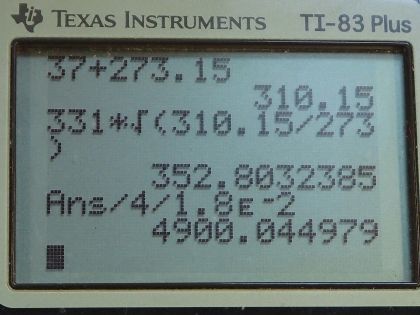Question
The ear canal resonates like a tube closed at one end. (See Figure 17.38.) If ear canals range in length from 1.80 to 2.60 cm in an average population, what is the range of fundamental resonant frequencies? Take air temperature to be , which is the same as body temperature. How does this result correlate with the intensity versus frequency graph (Figure 17.36 of the human ear?
Final Answer
Resonant fundamental frequencies range from 3.39 kHz to 4.40 kHz.
For a given perceived volume there is a decrease in the intensity required to produce that volume in this frequency range. This is presumably the result of resonance in the ear canal for these frequencies.
Solution video
OpenStax College Physics, Chapter 17, Problem 50 (Problems & Exercises)

vote with a rating of
votes with an average rating of
.
Calculator Screenshots
Video Transcript
This is College Physics Answers with Shaun Dychko. The ear canal resonates as a tube closed at one end which means that its fundamental frequency can be given by the formula n times the speed of sound divided by 4 times its length or n is one of the odd natural numbers— 1, 3, 5 and so on. So we are told that the length of an ear canal ranges from 1.80 centimeters up to 2.60 centimeters and the temperature in the ear cancel we assume is body temperature, which is 37.0 degrees Celsius, which we convert into Kelvin by adding 273.15. So to find the frequency of the fundamental length L a, we have to figure out what the speed of sound is first and that will be 331 meters per second times square root of the absolute temperature divided by 273. So that's 331 meters per second times square root of 310.15 Kelvin divided by 273 which is 352.803 meters per second. So we take that speed of sound, substitute it in for v and divide by 4 times the length of the ear canal at the lower limit of 1.80 centimeters which we write as 1.80 times 10 to the minus 2 meters and that's 4.90 kilohertz. And the upper limit to the ear canal length gives the lower limit of the frequency here because the maximum denominator will produce the minimum quotient so anyway... f 1b is gonna be 352.803 meters per second divided by 4 times 2.60 times 10 to the minus 2 meters and that's 3.39 kilohertz. And we can see from this graph here, each of these lines corresponds to a given perceived volume and the volume is measured in these units called phon and these are perceived volumes and the perceived volume will require different intensities for different frequencies. So for the frequency in the range that we found here— 3.40 kilohertz which is approximately here up to about 5 kilohertz which is about there— there's a dip in the intensity required for a given perceived volume. So the threshold of hearing is in the purple line and the dip is most significant there and we can see that there's a very small intensity needed in this range for that threshold of hearing. And likewise for 40 phons of volume... perceived volume I should say, there's a dip here as well and so this says that it's easier to hear these frequencies presumably since these frequencies are resonating in the ear canal.

